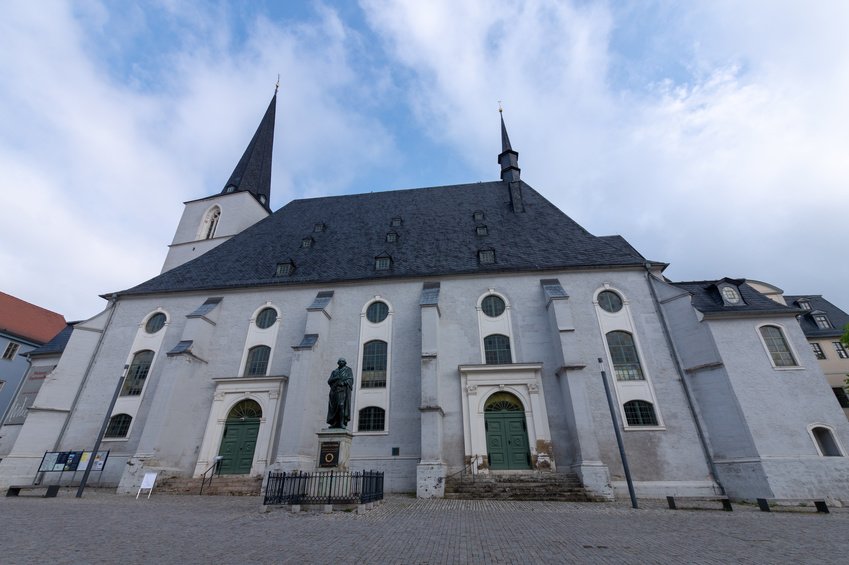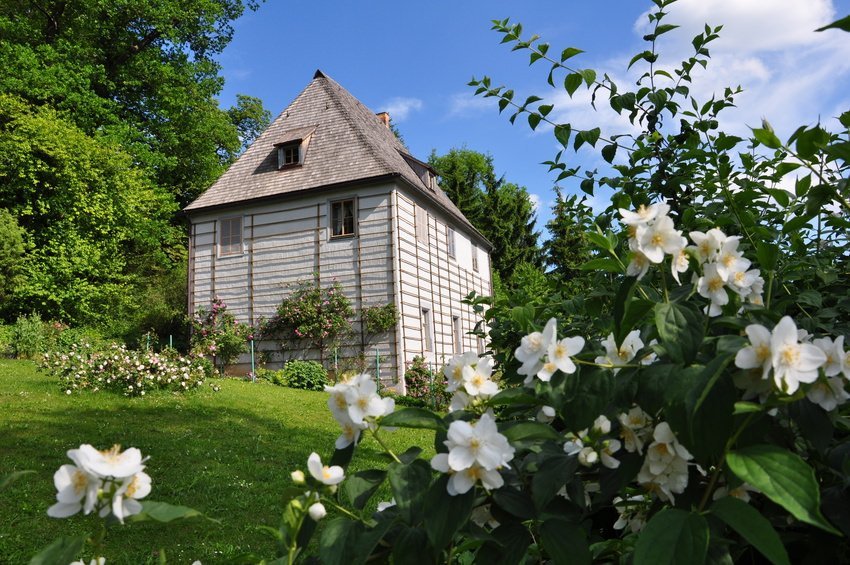
It may not have Berlin’s bright lights or Frankfurt’s thriving party scene, but for those looking for some quiet reflection in a cultural focal point a trip to Weimar is a must.
Located in the state of Thuringia, which is known as Germany’s green heart for its lush woodland forests, the city of Weimar is a treasure chest of architectural and historical gems.
A Rich Cultural Legacy
Many vitally important figures in German art and literature lived and worked in Weimar. To just name a few of them, there was the baroque composer, Johann Sebastian Bach, the German writer, Johann Wolfgang von Goethe, and Friedrich Schiller. These other luminaries have all left an indelible mark on the city of Weimar in central Germany.

Weimar emerged as Germany’s intellectual centre at the end of the 18th century, and in many ways it still is. It was the focal point of the German enlightenment, and it is also the birthplace of the Bauhaus design movement.
The city’s authorities and residents are aware of this cultural heritage and have lovingly worked hard to preserve it. The result is that Weimar is a favourite tourist destination in Germany with a complete programme of cultural events.
Where Is It?
Weimar is located conveniently in the middle of Germany in the state of Thuringia. The closest major city to the west is Erfurt and Jena is to the east, a mere 20-minute train ride away. These three cities collectively form the Central Metropolitan area of Thuringia that around 500,000 permanent residents call home. As for Weimar itself, the city is relatively small with a population of approximately 65,000.
If you’re planning on touring the Autobahn, you’ll be glad to know that Weimar is 170 kilometres north of Nuremberg. It’s the same distance from Dresden going West, and it’s only 80km southwest of Leipzig. Thus, even if you aren’t planning on staying in Weimar for any great length of time, it’s still a great destination for a day trip.
Places to See in Weimar
The truth of the matter is that although you may be planning to only spend a day in Weimar, you wouldn’t be the first tourist who comes for a day and ends up staying a week! Like many others who initially only thought they’d be passing through Weimar, you may very well end up staying for an extended period of time.
The truth of the matter is that there is a lot to see and do in this small central German city. From its many museums to its riverside parks to its historic churches that date back centuries, it simply isn’t possible to see everything that Weimar has to offer travellers over the course of a single day.
Stadtkirche St. Peter und Paul
Of the many beautiful old churches in Weimar, the most impressive is the Stadkirche (which means ‘town church’) of St. Peter und Paul. It’s also the oldest, and the foundation of the current building dates back to what remains of the original church that was built in the mid-thirteenth century. The original church was destroyed by fire in 1299, as was the church that replaced it a little over a century later during a sweeping town fire in 1424.
The current church building was built between 1498 and 1500. It is a stunning example of late Gothic architecture. Stadtkirche St. Peter und Paul has been officially Lutheran since 1525, and Martin Luther himself gave many of his sermons there.

Once inside the church, you can’t help but be amazed at the altarpiece. This painting was created by a father and son. It begun in 1552 by Lucas Cranach Senior shortly before his death and was finished by his son Lucas Cranach Junior in 1555. This large triptych portrays the crucifixion scene, only it places Christ on the cross in the city of Weimar instead of Golgotha. The painting thus gives the modern viewer an opportunity to look into the past and see how the city of Weimar was in the middle of the 16th century.
Historic houses turned into museums
There are many libraries and museums in Weimar, and a culturally curious tourist can easily spend an entire day perusing and learning in any one of them. The are three museums in Weimar that are absolute must-sees, and these are the former homes of Johann Wolfgang von Goethe, Friedrich Schiller, and the philosopher, Friedrich Nietzsche. All three of these centuries-old residences have been converted into museums that are open to the public.

Of the three, the literary celebrity and political advisor, Johann Wolfgang Von Goethe, spent the most time living in Weimar. The baroque style home he lived and wrote in for nearly fifty years was left to the German state by Goethe’s grandson and last living heir Walter Von Goethe. Along with an addition constructed in 1935, this house is now the Goethe-Nationalmuseum.
Here visitors can walk through the rooms in which Goethe and his wife lived. These rooms are time capsules, furnished with items that are true to the historic period (Goethe lived in this house from 1782 to 1832). The extension built in 1935 houses Goethe’s collections. Anyone wishing to visit the Goethe house should get there early, as there is a limit to the number of guests that can enter.

One of Goethe’s closest contemporaries was Friedrich Schiller, another renaissance man who wrote plays, poetry, and philosophy. Together, Schiller and Goethe are credited with spearheading the literary movement known as Weimar classicism. The house in Weimar, where Schiller lived from 1802 until his death in 1805, is also a museum. The study where Schiller wrote his acclaimed dramas ‘The Bride of Messina’ and ‘William Tell’ is completely authentic, and many of the furnishings are originals.
The philosopher Friedrich Nietzsche came to Weimar to die, and the house where he spent the final few years of his life before he passed away in 1900 is now the Nietzsche-Archiv. This house is where the philosopher’s sister Elisabeth brought a syphilitic and mentally incapable Friedrich Nietzche so she could care for him. Elisabeth also founded the Nietzsche-Archiv in 1894.
Today, this museum features a detailed exhibition on the famous philosopher’s life. It should be that the actual archives are split up between this site and two others in Weimar (the Goethe-Schiller archives and the Duchess Anna Amalia library). The Nietzsche-Archiv is located about a 20-minute walk out of the Weimar city centre, but it’s a nice walk that goes through a popular tourist attraction in Weimar).












